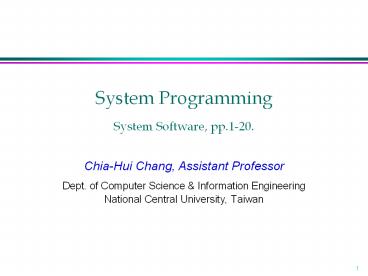System Programming System Software, pp.1-20. - PowerPoint PPT Presentation
1 / 21
Title:
System Programming System Software, pp.1-20.
Description:
The Simplified Instructional Computer (SIC) SIC is a hypothetical computer that includes the hardware features ... SIC Machine Architecture (2/4) Data Formats ... – PowerPoint PPT presentation
Number of Views:346
Avg rating:3.0/5.0
Title: System Programming System Software, pp.1-20.
1
System ProgrammingSystem Software, pp.1-20.
- Chia-Hui Chang, Assistant Professor
- Dept. of Computer Science Information
Engineering - National Central University, Taiwan
2
Introduction
- Definition
- System software consists of a variety of programs
that support the operation of a computer - One characteristic in which most system software
differ from application software is machine
dependency - Example
- e.g. when you took the first programming course
- text editor, compiler, loader or linker, debugger
- e.g. when you wrote assembler language
- assembler, macro processor
- e.g. you control all of these processes by
interacting with the operation system
3
System Software vs. Machine Architecture
- One characteristic in which most system software
differ from application software is machine
dependency - e.g. assembler translate mnemonic instructions
into machine code - e.g. compilers must generate machine language
code - e.g. operating systems are directly concerned
with the management of nearly all of the
resources of a computing system - There are some aspects of system software that do
not directly depend upon the type of computing
system - e.g. general design and logic of an assembler
- e.g. code optimization techniques
4
The Simplified Instructional Computer (SIC)
- SIC is a hypothetical computer that includes the
hardware features most often found on real
machines - Two versions of SIC
- standard model
- XE version
5
SIC Machine Architecture (1/4)
- Memory
- 8-bit bytes
- 3 consecutive bytes form a word
- 215 bytes in the computer memory
- Registers
6
SIC Machine Architecture (2/4)
- Data Formats
- Integers are stored as 24-bit binary numbers 2s
complement representation is used for negative
values - No floating-point hardware
- Instruction Formats
- Addressing Modes
x
opcode (8)
address (15)
7
SIC Machine Architecture (3/4)
- Instruction Set
- load and store LDA, LDX, STA, STX, etc.
- integer arithmetic operations ADD, SUB, MUL,
DIV, etc. - All arithmetic operations involve register A and
a word in memory, with the result being left in
the register - comparison COMP
- COMP compares the value in register A with a word
in memory, this instruction sets a condition code
CC to indicate the result - conditional jump instructions JLT, JEQ, JGT
- these instructions test the setting of CC and
jump accordingly - subroutine linkage JSUB, RSUB
- JSUB jumps to the subroutine, placing the return
address in register L - RSUB returns by jumping to the address contained
in register L
8
SIC Machine Architecture (4/4)
- Input and Output
- Input and output are performed by transferring 1
byte at a time to or from the rightmost 8 bits of
register A - The Test Device (TD) instruction tests whether
the addressed device is ready to send or receive
a byte of data - Read Data (RD)
- Write Data (WD)
9
SIC Programming Examples (Fig 1.2)
10
SIC Programming Examples
- Data movement
- No memory-memory move instruction
- 3-byte word LDA, STA, LDL, STL, LDX, STX
- 1-byte LDCH, STCH
- Storage definition
- WORD, RESW
- BYTE, RESB
11
SIC Programming Examples (Cont.)
- Arithmetic
- Arithmetic operations are performed using
register A, with the result being left in
register A - Looping (TIX)
- (X)(X)1
- compare with operand
- set CC
Break...
12
SIC/XE Machine Architecture (1/4)
- Memory
- 220 bytes in the computer memory
- More Registers
13
SIC/XE Machine Architecture (2/4)
- Data Formats
- Floating-point data type frac2(exp-1024)
- frac 01
- exp 02047
- Instruction Formats
- larger memory -gt extend addressing capacity
14
SIC/XE Machine Architecture (3/4)
- Addressing Modes
- How the target address is used?
- Note Indexing cannot be used with immediate or
indirect addressing modes
15
SIC/XE Machine Architecture (4/4)
- Instruction Set
- new registers LDB, STB, etc.
- floating-point arithmetic ADDF, SUBF, MULF, DIVF
- register move RMO
- register-register arithmetic ADDR, SUBR, MULR,
DIVR - supervisor call SVC
- generates an interrupt for OS (Chap 6)
- Input/Output
- SIO, TIO, HIO start, test, halt the operation of
I/O device (Chap 6)
16
SIC/XE Programming Example
- data movement
- immediate addressing for SIC/XE
- arithmetic
- Looping (TIXR)
- (X)(X)1
- compare with register specified
- set CC
17
SIC Programming Example (Fig 1.3)
18
SIC Programming Example (Fig 1.4)
19
SIC Programming Example (Fig 1.5)
20
SIC Programming Example (Fig 1.6)
21
(No Transcript)































